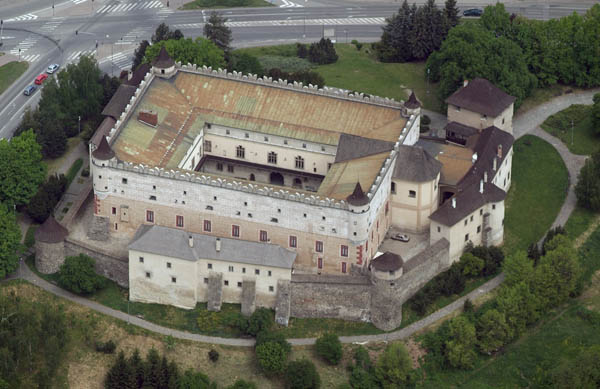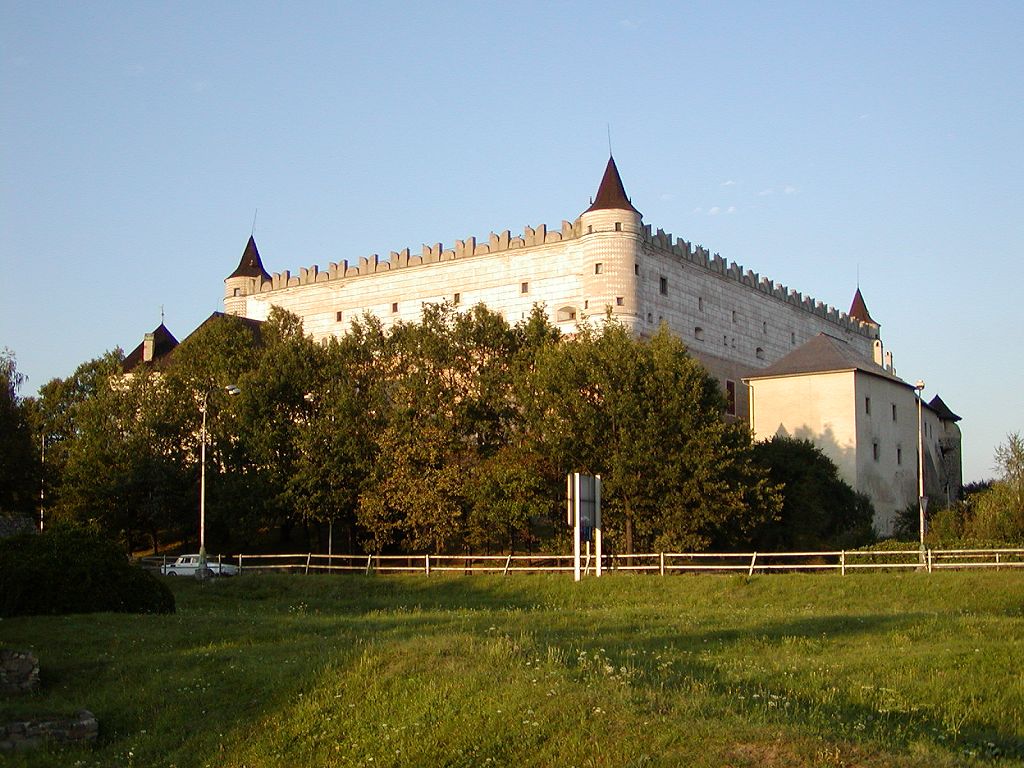|
Zólyom County
Zólyom county (in Latin: ''comitatus Zoliensis'', in Hungarian ''Zólyom (vár)megye'', in Slovak ''Zvolenský komitát/ Zvolenská stolica/ Zvolenská župa'', in German ''Sohler Gespanschaft/Komitat Sohl'') was an administrative county (comitatus) of the Kingdom of Hungary. Its territory is now in central Slovakia. Geography Zólyom county shared borders with the counties of Bars, Turóc, Liptó, Gömör-Kishont, Nógrád and Hont. The county's territory was situated along the central Garam river, approximately between (excluding) Korpona and (including) Breznóbánya. Its area was 2634 km2 around 1910. The county was characterised by extensive mining activities. Capitals The capital of the county was the castle of Pusztavár near Zólyom, then from the late 15th century the Zvolen Castle ( hu, Zólyomi vár) and from the 1760s the town of Besztercebánya. History Zólyom county arose as a Hungarian comitatus in the 14th century, when most parts of the territ ... [...More Info...] [...Related Items...] OR: [Wikipedia] [Google] [Baidu] |
Comitatus (Kingdom Of Hungary)
''Comitatus'' was in ancient times the Latin term for an armed escort or retinue. The term is used especially in the context of Germanic warrior culture for a warband tied to a leader by an oath of fealty and describes the relations between a lord and his retainers, or thanes (OE þegn). The concept is generally considered by scholars to be more of a literary trope rather than one of historical accuracy. Scholars Bruce Mitchell and Fred C. Robinson describe the ''comitatus'' more fully:An heroic warrior brought up in this 'comitatus''tradition would show a reckless disregard for his life. Whether he was doomed or not, courage was best, for the brave man could win ''lof'' lory among menwhile the coward might die before his time. This is the spirit which inspired the code of the ''comitatus''. While his lord lived, the warrior owed him loyalty unto death. If his lord were killed, the warrior had to avenge him or die in the attempt. The lord in his turn had the duty of being genero ... [...More Info...] [...Related Items...] OR: [Wikipedia] [Google] [Baidu] |
Zvolen Castle
Zvolen Castle ( sk, Zvolenský zámok or incorrectly , hu, zólyomi vár) is a medieval castle located on a hill near the center of Zvolen, in central Slovakia. It was a part of the Kingdom of Hungary from the 1370's until the Treaty of Trianon in 1920. The original seat of the region was above the confluence of Slatina and Hron rivers on a steep cliff in a castle from the 12th century, known today as Pustý hrad (meaning "Deserted castle"). Its difficult access had consequence in relocation of the seat to the new-built Zvolen castle, which was ordered by Louis I the Great as a hunting residence of Hungarian kings. The future queen regnant Mary of Hungary and emperor Sigismund celebrated their wedding there in 1385. Gothic architecture of the castle built between 1360 and 1382 was inspired by Italian castles of the fourteenth century. Italian masons also contributed to a Renaissance reconstruction in 1548. The last major reconstruction occurred in 1784, when the cha ... [...More Info...] [...Related Items...] OR: [Wikipedia] [Google] [Baidu] |
Hungarian Language
Hungarian () is an Uralic language spoken in Hungary and parts of several neighbouring countries. It is the official language of Hungary and one of the 24 official languages of the European Union. Outside Hungary, it is also spoken by Hungarian communities in southern Slovakia, western Ukraine (Subcarpathia), central and western Romania ( Transylvania), northern Serbia ( Vojvodina), northern Croatia, northeastern Slovenia ( Prekmurje), and eastern Austria. It is also spoken by Hungarian diaspora communities worldwide, especially in North America (particularly the United States and Canada) and Israel. With 17 million speakers, it is the Uralic family's largest member by number of speakers. Classification Hungarian is a member of the Uralic language family. Linguistic connections between Hungarian and other Uralic languages were noticed in the 1670s, and the family itself (then called Finno-Ugric) was established in 1717. Hungarian has traditionally been assigned to ... [...More Info...] [...Related Items...] OR: [Wikipedia] [Google] [Baidu] |
Slovak Language
Slovak () , is a West Slavic language of the Czech–Slovak group, written in Latin script. It is part of the Indo-European language family, and is one of the Slavic languages, which are part of the larger Balto-Slavic branch. Spoken by approximately 5 million people as a native language, primarily ethnic Slovaks, it serves as the official language of Slovakia and one of the 24 official languages of the European Union. Slovak is closely related to Czech, to the point of mutual intelligibility to a very high degree, as well as Polish. Like other Slavic languages, Slovak is a fusional language with a complex system of morphology and relatively flexible word order. Its vocabulary has been extensively influenced by Latin and German and other Slavic languages. The Czech–Slovak group developed within West Slavic in the high medieval period, and the standardization of Czech and Slovak within the Czech–Slovak dialect continuum emerged in the early modern period. In ... [...More Info...] [...Related Items...] OR: [Wikipedia] [Google] [Baidu] |
First Language
A first language, native tongue, native language, mother tongue or L1 is the first language or dialect that a person has been exposed to from birth or within the critical period. In some countries, the term ''native language'' or ''mother tongue'' refers to the language or dialect of one's ethnic group rather than one's first language. The first language of a child is part of that child's personal, social and cultural identity. Another impact of the first language is that it brings about the reflection and learning of successful social patterns of acting and speaking. Research suggests that while a non-native speaker may develop fluency in a targeted language after about two years of immersion, it can take between five and seven years for that child to be on the same working level as their native speaking counterparts. On 17 November 1999, UNESCO designated 21 February as International Mother Language Day. Definitions One of the more widely accepted definitions of native ... [...More Info...] [...Related Items...] OR: [Wikipedia] [Google] [Baidu] |
Zólyom Ethnic Map
Zvolen (; hu, Zólyom; german: Altsohl) is a town in central Slovakia, situated on the confluence of Hron and Slatina rivers, close to Banská Bystrica. It is surrounded by Poľana mountain from the East, by Kremnické vrchy from the West and by Javorie and Štiavnické vrchy from the South. Zvolen is a seat of a county (Zvolen District). It is also an important transportation hub in Slovakia. Etymology The name is of Slovak (Slavic) origin meaning "the chosen one, splendid, excellent". The Hungarian ' and the German ' were derived from the Latinized form ' (earliest mention 1135). An adjective "Old" (german: Altsohl, sk, Starý Zvolen, la, Antiquum or Vetus Solium) distinguish Zvolen from Banská Bystrica (german: Sohl, Neusohl). History Zvolen has been inhabited since the Paleolithic. In the ninth century, a Slavic settlement (today the Môťová neighborhood) became a regional center of what is now central Slovakia. Zvolen remained the capital of Zólyom County unt ... [...More Info...] [...Related Items...] OR: [Wikipedia] [Google] [Baidu] |
Banská Bystrica Region
The Banská Bystrica Region ( sk, Banskobystrický kraj, ; hu, Besztercebányai kerület, ) is one of the Regions of Slovakia, eight regions of Slovakia. It is the largest region by area, and has a lower population density than any other region. The Banská Bystrica region was established in 1923; its borders were last adjusted in 1996. Banská Bystrica consists of 514 municipalities, 24 of which have town status. Its administrative center is the eponymous town of Banská Bystrica, which is also the region's largest town. Other important towns are Zvolen and Lučenec. Geography It is located in the central part of Slovakia and has an area of 9,455 km2. The region is prevailingly mountainous, with several ranges within the area. The highest of them are the Low Tatras in the north, where the highest point, Ďumbier, is located. Some of the mountain ranges in the west include Kremnica Mountains, Vtáčnik and Štiavnica Mountains. The Javorie and Krupina Plain ranges are locate ... [...More Info...] [...Related Items...] OR: [Wikipedia] [Google] [Baidu] |
Slovak State
Slovak may refer to: * Something from, related to, or belonging to Slovakia (''Slovenská republika'') * Slovaks, a Western Slavic ethnic group * Slovak language, an Indo-European language that belongs to the West Slavic languages * Slovak, Arkansas, United States See also * Slovák, a surname * Slovák, the official newspaper of the Slovak People's Party Hlinka's Slovak People's Party ( sk, Hlinkova slovenská ľudová strana), also known as the Slovak People's Party (, SĽS) or the Hlinka Party, was a far-right clerico-fascist political party with a strong Catholic fundamentalist and authorita ... * {{disambiguation, geo Language and nationality disambiguation pages ... [...More Info...] [...Related Items...] OR: [Wikipedia] [Google] [Baidu] |
Treaty Of Trianon
The Treaty of Trianon (french: Traité de Trianon, hu, Trianoni békeszerződés, it, Trattato del Trianon) was prepared at the Paris Peace Conference and was signed in the Grand Trianon château in Versailles on 4 June 1920. It formally ended World War I between most of the Allies of World War I and the Kingdom of Hungary. French diplomats played the major role in designing the treaty, with a view to establishing a French-led coalition of the newly formed states. It regulated the status of the Kingdom of Hungary and defined its borders generally within the ceasefire lines established in November–December 1918 and left Hungary as a landlocked state that included , 28% of the that had constituted the pre-war Kingdom of Hungary (the Hungarian half of the Austro-Hungarian monarchy). The truncated kingdom had a population of 7.6 million, 36% compared to the pre-war kingdom's population of 20.9 million. Though the areas that were allocated to neighbouring countries had a ... [...More Info...] [...Related Items...] OR: [Wikipedia] [Google] [Baidu] |
Czechoslovakia
, rue, Чеськословеньско, , yi, טשעכאסלאוואקיי, , common_name = Czechoslovakia , life_span = 1918–19391945–1992 , p1 = Austria-Hungary , image_p1 = , s1 = Czech Republic , flag_s1 = Flag of the Czech Republic.svg , s2 = Slovakia , flag_s2 = Flag of Slovakia.svg , image_flag = Flag of Czechoslovakia.svg , flag = Flag of Czechoslovakia , flag_type = Flag(1920–1992) , flag_border = Flag of Czechoslovakia , image_coat = Middle coat of arms of Czechoslovakia.svg , symbol_type = Middle coat of arms(1918–1938 and 1945–1961) , image_map = Czechoslovakia location map.svg , image_map_caption = Czechoslovakia during the interwar period and the Cold War , national_motto = , anthems = ... [...More Info...] [...Related Items...] OR: [Wikipedia] [Google] [Baidu] |
World War I
World War I (28 July 1914 11 November 1918), often abbreviated as WWI, was List of wars and anthropogenic disasters by death toll, one of the deadliest global conflicts in history. Belligerents included much of Europe, the Russian Empire, the United States, and the Ottoman Empire, with fighting occurring throughout Europe, the Middle East, Africa, the Pacific Ocean, Pacific, and parts of Asia. An estimated 9 million soldiers were killed in combat, plus another 23 million wounded, while 5 million civilians died as a result of military action, hunger, and disease. Millions more died in Genocides in history (World War I through World War II), genocides within the Ottoman Empire and in the Spanish flu, 1918 influenza pandemic, which was exacerbated by the movement of combatants during the war. Prior to 1914, the European great powers were divided between the Triple Entente (comprising French Third Republic, France, Russia, and British Empire, Britain) and the Triple A ... [...More Info...] [...Related Items...] OR: [Wikipedia] [Google] [Baidu] |





.jpg)